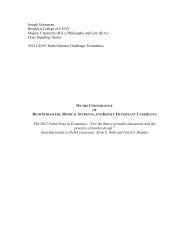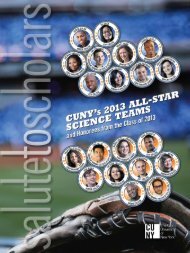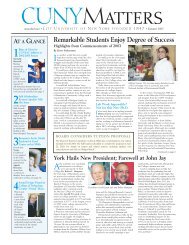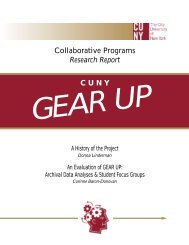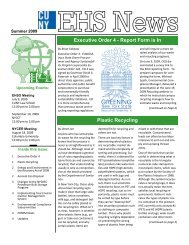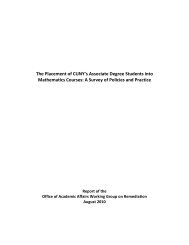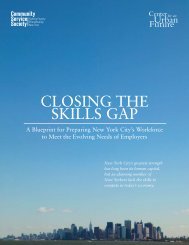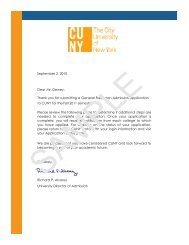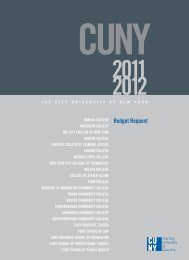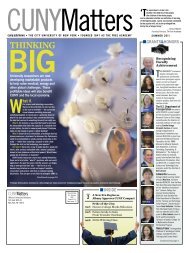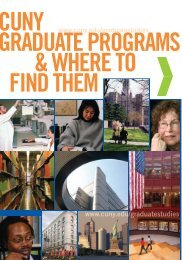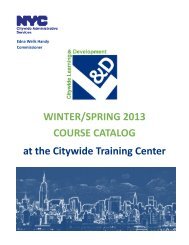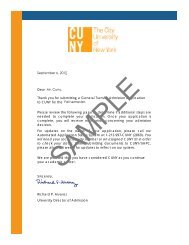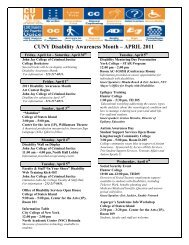CUNY Master Plan 2012-2016
CUNY Master Plan 2012-2016
CUNY Master Plan 2012-2016
Create successful ePaper yourself
Turn your PDF publications into a flip-book with our unique Google optimized e-Paper software.
THE <strong>CUNY</strong> MASTER PLAN <strong>2012</strong>-<strong>2016</strong><br />
To ensure that students can access and complete a college education that will support their advancement,<br />
<strong>CUNY</strong> will continue to take a lead in advocating for the availability of robust state and federal financial aid.<br />
New York State has a rich program of financial aid through the Tuition Assistance Program (TAP), and<br />
students can also receive Pell Grants through the federal government. However, New York City is expensive,<br />
and many demands compete for limited resources. <strong>CUNY</strong> will therefore continue to lobby the state<br />
and federal governments and to present the case that the best investment the United States can make—<br />
the investment most likely to help America advance economically and enable it to compete in world markets—is<br />
an investment in higher education.<br />
The legislation that has provided <strong>CUNY</strong> with stable funding for the next four years includes a provision<br />
directing <strong>CUNY</strong> and SUNY to conduct studies of the TAP program and to develop recommendations<br />
to further improve student financial aid in New York State. This dialogue has begun. Among the important<br />
issues to address are the needs to increase the maximum TAP award up to the highest public sector<br />
tuition in New York State, address a disparity with the TAP award calculation as it pertains to independent<br />
students, and expand tuition assistance to part-time students.<br />
<strong>CUNY</strong> is committed to ensuring that no student in need of financial assistance is denied access to the<br />
University. To that end, funds have been budgeted to help students with severe financial needs to bridge<br />
the gap between the maximum TAP award and tuition. In addition, a $5 million Student Financial Assistance<br />
Program ($2 million for a student employment program, $2 million for textbooks to be held in the<br />
library, and $1 million for an additional tuition waiver program) will provide further financial assistance.<br />
Few public universities take money from their operating budgets and dedicate it to financial aid for students;<br />
that <strong>CUNY</strong> does so reflects the values of its leadership.<br />
The University is also concerned that students’ financial aid be protected from annual budget battles,<br />
and that the state and federal governments be realistic regarding the years needed for students to graduate.<br />
On the federal level, the Chancellor will continue to mobilize leadership as evidenced by the two<br />
national summits cited earlier in this plan, and will continue to fight reductions to the Pell program. In<br />
addition, he has endorsed efforts to provide financial assistance to undocumented students and to establish<br />
pathways to citizenship, as well as financial aid, through the Dream Act and similar legislation.<br />
In addition, <strong>CUNY</strong>’s Office of Admissions will build on its proactive efforts to assist students in understanding<br />
the cost of college, the types of financial aid available, and the requirements and deadlines for aid<br />
applications. Through its comprehensive website, extensive in-person and electronic outreach, and expert<br />
counseling, the admissions office will continue to serve as a one-stop resource center for all students.<br />
The challenge of maximizing financial aid is an example of the University’s focus, as is borne out in this<br />
<strong>Master</strong> <strong>Plan</strong>, first, on students having rigorous, high-quality educational experiences, and second, on<br />
doing whatever is necessary to keep students on track to have those experiences.<br />
Responding to Basic Student Needs: The SingleStop Initiative<br />
<strong>CUNY</strong> students’ financial needs are not limited to funds for tuition. Sixty percent of <strong>CUNY</strong> students<br />
come from the lowest income brackets in America. Many face challenges with housing and food security,<br />
60



